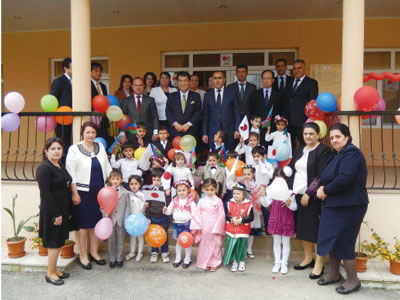Diplomatic Bluebook 2015
Chapter 2
Japan’s Foreign Policy that Takes a Panoramic Perspective of the World Map
2.Central Asian and Caucasian Countries
(1) Central Asian Countries
The “Central Asia plus Japan” Dialogue, as a framework to promote regional cooperation among Central Asian countries, marked its 10th anniversary in 2014. During the 10 years of its activity, the member countries concerned have come to share common understanding that regional cooperation is essential for the stability and development of Central Asia.
In this context, the Sixth Tokyo Dialogue (Intellectual Dialogue) took up “agriculture” as a theme for practical regional cooperation and experts from Japan and Central Asia discussed areas and measures for possible cooperation. Japan-Central Asia cooperation projects are not limited to cooperation between governments but aim at “all-Japan” cooperation including Japanese companies. In July, Foreign Minister Kishida attended the 5th foreign ministers’ conference held in the Kyrgyz Republic. Ministers discussed agriculture, counternarcotics/border management, disaster prevention and other issues and adopted a joint statement and a roadmap for cooperation in agriculture.
 Foreign Minister Kishida attending the 5th foreign ministers’ conference (Bishkek, Kyrgyz, July 16)
Foreign Minister Kishida attending the 5th foreign ministers’ conference (Bishkek, Kyrgyz, July 16)
Japan’s relations with each countries in Central Asia have been generally improving. There were active mutual visits of officials including Parliamentary Vice-Minister for Foreign Affairs Makino’s visit to Turkmenistan (April), Deputy Prime Minister and Finance Minister Aso’s visit to Uzbekistan (May), Parliamentary Vice-Minister for Foreign Affairs Sonoura’s visit to Uzbekistan and Tajikistan (November), and the visits to Japan by Foreign Minister Aslov of Tajikistan (June) and Speaker of the Parliament Jeenbekov of the Kyrgyz Republic (November).
With Japanese companies entering not only resource development but also manufacturing industry in Kazakhstan, a Japan-Kazakhstan investment agreement was signed in October.
(2) Caucasian countries
From Georgia, President Margvelashvili who was elected in the presidential election in the previous year visited Japan in October and had a summit meeting with Prime Minister Abe. Georgia took its approach to the EU a step further by signing an association agreement including the Deep and Comprehensive Free Trade Area (DCFTA) with the EU in June. The leaders agreed to continued cooperation between the two countries sharing universal values including democracy. In addition, Parliamentary Vice-Minister for Foreign Affairs Makino visited Azerbaijan in April.
As for Armenia, a Japanese embassy opened in the country on January 1, 2015. With this, Japanese embassies have been set up in all Caucasian countries. Even closer bilateral ties are expected.
Caucasian countries are burdened with disputes over territory including conflict over South Ossetia and Abkhazia1 in Georgia and the Nagorno-Karabakh Problems2 between Azerbaijan and Armenia, and tension still remains between the countries involved. Efforts toward resolution have been made but without any progress.
 Parliamentary Vice-Minister for Foreign Affairs Makino visiting kindergarten in Mijan Village of the Ismayilli Region, Azerbaijan (Azerbaijan, April 27)
Parliamentary Vice-Minister for Foreign Affairs Makino visiting kindergarten in Mijan Village of the Ismayilli Region, Azerbaijan (Azerbaijan, April 27)
- 1 In August 2008, Russian armed forces intervened in an armed crash between Georgia and South Ossetia that was seeking separation and independence from Georgia. The intervention developed into armed conflicts between Georgia and Russia. After about one week they ceased fire through intervention by then EU chair country France and others. Based on the agreement made at the time, an international conference was held in Geneva to discuss security and humanitarian issues.
- 2 Conflict over Nagorno-Karabakh between Armenia and Azerbaijan. Because the majority of residents of the area located in Azerbaijan are Armenians, demands to change the area from Azerbaijan to Armenia increased in the last years of the Soviet Union. With the dissolution of the Soviet Union in 1991, the situation developed into a conflict between Armenia and Azerbaijan. Armenia occupied almost the entirety of Nagorno-Karabakh and a corridor region leading to Armenia by 1993. A ceasefire agreement was made mediated by Russia and the OSCE in 1994, but the two countries have been repeating clashes involving casualties. Since 1999, direct dialogues have been continued at various levels including the top and foreign minister levels of the two countries mediated by the OSCE Minsk Group.
